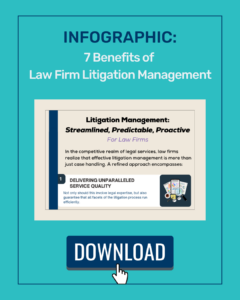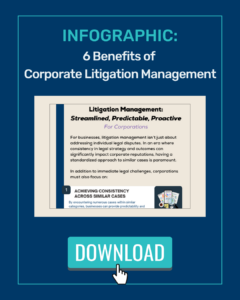Litigation management is a cornerstone for corporations navigating complex litigation, including contract disputes, regulatory compliance issues, multidistrict litigation (MDLs), class action law suits, and everything in between. These legal challenges often involve hundreds of plaintiffs, extensive evidence, including terabytes of electronically stored information (ESI), and layered legal arguments.
Having an effective strategy provides a roadmap, ensuring resources are used effectively, and all involved parties are in sync. It’s not just about safeguarding finances. It’s a framework for efficiency, standardization, and the use of historical precedents to guide decisions.
This comprehensive approach helps maintain the company’s integrity and ensures compliance with legal requirements. Without a strong litigation management strategy, corporations may find themselves in extended disputes, with both financial and reputational risks at stake.
Seeing Both the Forest and the Trees
One way litigation management helps protect against these risks is by equipping legal professionals with the ability to “see both the forest and the trees.”
The “forest” represents the holistic strategy, capturing the essence of the broader litigation landscape. It’s about understanding the general trajectory of a case, charting the course, and setting long-term objectives. This panoramic view ensures corporations navigate legal challenges with a clear direction, always keeping an eye on the overarching goals.
In contrast, the “trees” focus on the granular components of litigation: the individual legal issues, specific pieces of evidence, and detailed arguments that form the core of any case. These are the day-to-day elements that require meticulous attention, ensuring nothing slips through the cracks.
This ability to seamlessly transition between the macro and micro perspectives is essential. It guarantees that while the broader strategy is always front and center, every crucial detail is given its due diligence.
Different Perspectives
While having the ability to “see both the forests and the trees” is universally beneficial, the organization in which you work brings its own unique motivations and advantages when discussing litigation management.
For law firms, their primary drive often revolves around client satisfaction, maintaining the firm’s reputation, and the financial viability of their services.
A law firm is inherently a business, and successful litigation management can differentiate the firm in a competitive market, ensuring client retention and attracting new business. It also enhances their credibility in courtrooms and among peers.
On the other hand, in a corporate legal department, the motivations are often more internally focused. Here, litigation management is about safeguarding the company’s assets, reputation, and operational continuity in a cost-efficient manner.
Legal teams within corporations aim to preemptively identify risks, streamline internal communications, and work closely with other departments and external counsel to ensure that the company’s actions align with legal standards.
By doing so, they not only mitigate risks but also bring about cost-efficiencies. This approach puts them in a better position to translate complex legal scenarios into business decisions for corporate leaders.
In both scenarios, effective litigation management is the key to success, but the lens through which it is measured differs.
Enabling Success Through Technology
Regardless of how success is defined, it’s clear that establishing a comprehensive litigation management strategy is the first step. This strategy, however, while vital, only sets the framework. To truly reap the benefits discussed, the right technology needs to be put in place.
Modern litigation management tools help transform this strategy from paper to practice, ensuring it’s implemented with precision and flexibility. From streamlining complex workflows and enhancing team communication to providing actionable reporting and insights, technology guarantees that the advantages of a well-devised strategy are actualized in the everyday operations of both law firms and corporate legal departments.
It’s this combination that ensures legal challenges are met head-on, with clarity, coherence, and effectiveness, underlining the undeniable importance of effective litigation management in today’s legal landscape.

Sara Coley
Author
Share article:
Sara Coley is a Senior Director, Client Services based in Asheville, North Carolina and has been with TCDI since 2012. As a Lean Six Sigma Black Belt, Sara brings a unique perspective to helping clients identify and create efficient processes, helping them streamline their legal operations. Learn more about Sara.







